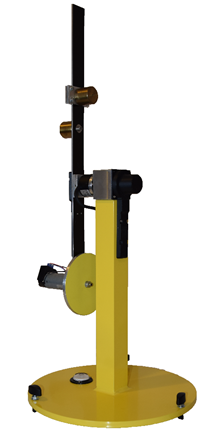Reaction Wheel Pendulum
Reaction Wheel Pendulum (RWP) is an inverted pendulum type device designed for control education and research. From a control theory point of view RWP is an unstable, nonlinear system to some extent similar to the Inverted Pendulum. To swing up and stabilise the system in an upright position DC motor drives a reaction  wheel (a type of flywheel) forward and backward. The appropriate direction and torque produced by the DC motor is calculated by a feedback control algorithm. The control algorithm is designed, adjusted and run on single PC with MATLAB/Simulink environment using Model Based Design technique.
wheel (a type of flywheel) forward and backward. The appropriate direction and torque produced by the DC motor is calculated by a feedback control algorithm. The control algorithm is designed, adjusted and run on single PC with MATLAB/Simulink environment using Model Based Design technique.
The RWP is equipped with power interface and multipurpose analog and digital I/O board. The system serves for testing and verifying in practice linear and nonlinear control algorithms. The control algorithms are designed and prepared in the MATLAB/Simulink environment and run as Real-Time procedure on the same PC.
The device is equipped with PWM controlled DC motor which drives a flywheel. Any change in rotational speed of reaction wheel influences rotational speed of the pendulum rod accordingly to conservation of angular momentum. The center of mass of the rod can be adjusted with counterweight thus affecting dynamics of the RWP.
When center of the mass is set above pivot point RWP becomes inverted pendulum – an unstable system which requires active control to maintain upright position. In case of center of the mass under pivot point RWP becomes stable, oscillating system.
Third option is setting center of the mass in the axis of rotation making the RWP fully balanced and stable in every point. The angle of the rod and flywheel are measured with incremental encoders. To transfer power and data signals from flywheel encoder slip ring is used. The advantage of this structure is limitless movement with no hazard in destroying wiring.
Hardware:
- Reaction Pendulum mechanical system
- DC motor 12V, PWM controlled
- two incremental encoders, one mounted at the DC motor axis to provide flywheel angle information (1024 imp/rpm quadrature), second mounted at pendulum axis (5000 imp/rpm quadrature) to provide information regarding pendulum angle
- two counterweights, one fixed and one adjustable to change pendulum characteristic
- power interface box containing a power supply, power amplifiers and signals conditioning unit
- RT-DAC I/O external USB2 board equipped with XILINX chip
Dimensions:
500x500x700 mm

